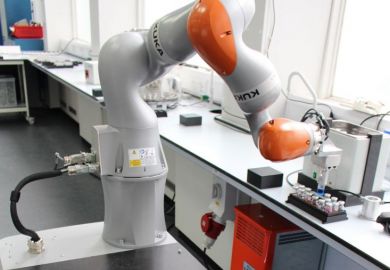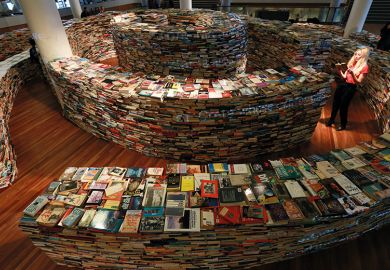Murder, medicine and surprise. Andrew Hughes looks at the elements.
My first experience of this book, before being asked to review it, was to see a student reading it in the fashion of a novel with 115 chapters. The book is indeed informative reading, not only for everyone who studies some chemistry and for every serious student of chemistry, but also for those who far too proudly boast that their knowledge and, more important, their learning of chemistry, ended at O level or earlier. Just as educated people should have some knowledge of music, an ability to appreciate art and fine wine, and have an informed opinion of modern politics, so they should have some understanding of science. The media is often guilty of treating science as difficult and scientists as boffins and eggheads, while assuming that we can all appreciate sculpture, paintings and a piece of classical music. This is compounded by those scientists who find it difficult to make their subjects understandable to the non-specialist. Fortunately, there are times when media-friendly science breaks through, and BBC Radio 4 has recorded four extracts from this book under the title "Elements of Surprise" - presented by media-friendly scientist Adam Hart-Davis. All that is needed now is a CD to be included inside the back cover of this book to make it an instant hit.
For all the complexity of the world around us, every animal, vegetable or mineral is made of the same limited number of chemical elements. The minerals of our planet, and the waters of our oceans contain about 90 different elements. Indeed, all of the stable elements can be found here, and even some radioactive ones. Human life depends on just 24 essential elements, many of them used only in trace amounts. The average adult has only about 2 milligrams of cobalt stored as vitamin B12, yet we contain similar amounts of other elements that are of no known benefit and many of which are toxic. Even toxicity is a relative term: while reusable antimony laxatives were popular in medieval times, now we are concerned that volatile antimony compounds might be released in tiny amounts from baby's mattresses and contribute to cot death.
John Emsley lectured in chemistry for many years before turning to a career bringing science to the masses. He now delights in the title of "science writer in residence" at the department of chemistry in Cambridge and has done much to bring to public attention the technological benefits of chemistry and other sciences. This book brings some fascinating chemistry to wider attention, using the elements to tell the tale.
While chemists are familiar with the periodic table of elements, here they are arranged in alphabetical order, apart from one chapter covering the so-called man-made transfermium elements. For each element we learn the origin of its name and how to pronounce it in several languages, including English and American, which are not always the same. Throughout history there have been trends in the sources used for names, with the elements named after ancient gods, colours, places and people, although it is only recently that living people have been so honoured. One section recounts the tale of the Swedish village of Ytterby that gave its name to four elements discovered in a local mineral.
We learn of the minerals from which an element can be obtained, and some of the chemistry and technology by which the pure element can be prepared. It is strange that isolation of the pure element has often fascinated chemists and non-chemists alike, when it is the chemistry of its compounds that is more significant. A section describing the oxides, hydrides and other compounds provides a brief survey of the chemistry of each element and, like the rest of the volume, this is written in as non-specialist a fashion as possible.
The sections that make this book more interesting and readable than a chemistry textbook include the elements of war and surprise. Sixteen chemical elements are identified as important to mankind's efforts to defeat enemies in war. These range through history from the iron of swords and weapons, the carbon, nitrogen and sulphur of gunpowder, the manganese, tungsten and vanadium of armour, to the hydrogen, uranium and plutonium of 20th-century warfare.
The "elements of surprise" comprise a collection of anecdotes and trivia, many of them well known but some that the author has searched to find. We read the well-known tale of how Napoleon is believed to have suffered from arsenic poisoning from the wallpaper in his exiled home on St Helena. By contrast, titanium is an element that has had a major technological impact on modern life, probably without many of us knowing. Titanium can be seen everywhere around us, since vast quantities of titanium dioxide are used as the white pigment in paints, sunscreens, toothpastes and lipsticks, and the metal itself is vital in modern construction. Silver is of course familiar from its use in cutlery and jewellery, yet silver iodide can be used to seed clouds and produce rainfall, and it is suggested that experiments by the Ministry of Defence were the cause of the flash flood that destroyed Lynmouth in 1952.
Is there anything missing? This is a book that everyone can read, so I tried to avoid reading it through the eyes of a professional chemist. One absence is a definition of an element, perhaps because it is difficult to avoid chemical or physical concepts that might scare the casual reader. According to my dictionary, an element is "a substance composed of atoms of the same atomic number". It is less than easy to explain atomic number without entering deeper into the realms of atomic structure, and a general chemistry book needs to avoid the "atomic" word.
Which brings us to the real question. Who is the target reader of this book? Without knowing the publisher's intended answer, it is tempting to suggest that this is a compulsory purchase for students of trivia, the producers of television quiz shows and those people who set the questions for pub quizzes. This is where you can find the answers to many questions for potential millionaires. What is the most expensive metal in the world? Answer: lutetium; the price per kilogram is six times that of gold, but do not expect to find jewellery made of it. What is the deadliest substance known? Polonium is a contender, a trillion times more toxic than hydrogen cyanide, and all of our bodies contain some polonium since it is a decay product of radon, a naturally occurring radioactive gas. And what was the last element to be discovered? Rhenium was discovered only in 1925 from the mineral gadolinite, which contains a mere ten parts per million of this element; the newer elements were man-made, not discovered.
This is a very readable and non-technical survey of the building blocks of not just chemistry, but also biology, biochemistry, geology, medicine, metallurgy and nutrition. It contains stories of the elements of war and peace, the history of elements, the elements of murder and medicine. All of the ingredients of a good work of fiction are here. It really is a good bedtime read for all.
Andrew Hughes is lecturer in chemistry, University of Durham.
Nature's building blocks: An A-Z Guide to the Elements
Author - John Emsley
ISBN - 0 19 850341 5
Publisher - Oxford University Press
Price - £20.00
Pages - 539


